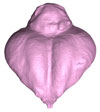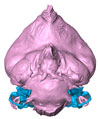|
|
This page serves supplemental imagery for a paper entitled Endocranial anatomy of the Charadriiformes: sensory system variation and the evolution of wing-propelled diving, by N.A. Smith and J.A. Clarke (2012, PLos ONE, 7(11), e49584). The abstract is as follows:
Just as skeletal characteristics provide clues regarding behavior of extinct vertebrates, phylogenetically-informed evaluation of endocranial morphology facilitates comparisons among extinct taxa and extant taxa with known behavioral characteristics. Previous research has established that endocranial morphology varies across Aves; however, variation of those systems among closely related species remains largely unexplored. The Charadriiformes (shorebirds and allies) are an ecologically diverse clade with a comparatively rich fossil record, and therefore, are well suited for investigating interspecies variation, and potential links between endocranial morphology, phylogeny, ecology and other life history attributes. Endocranial endocasts were rendered from high resolution X-ray computed tomography data for 17 charadriiforms (15 extant and two flightless extinct species). Evaluation of endocranial character state changes on a phylogeny for Charadriiformes resulted in identification of characters that vary in taxa with distinct feeding and locomotor ecologies. In comparison with all other charadriiforms, stem and crown clade wing-propelled diving Pan-Alcidae displayed compressed semicircular canals, and indistinct occipital sinuses and cerebellar fissures. Flightless wing-propelled divers have relatively smaller brains for their body mass and smaller optic lobes than volant pan-alcids. Observed differences between volant and flightless wing-propelled sister taxa are striking given that flightless pan-alcids continue to rely on the flight stroke for underwater propulsion. Additionally, the brain of the Black Skimmer Rynchops niger, a taxon with a unique feeding ecology that involves continuous forward aerial motion and touch-based prey detection used both at day and night, is discovered to be unlike that of any other sampled charadriiform in having an extremely large wulst as well as a small optic lobe and distinct occipital sinus. Notably, the differences between the Black Skimmer and other charadriiforms are more pronounced than between wing-propelled divers and other charadriiforms. Finally, aspects of endosseous labyrinth morphology are remarkably similar between divers and non-divers, and may deserve further evaluation.
About Alca torda
The Razorbill Auk Alca torda Linnaeus 1758 is a pelagic seabird (Charadriiformes, Pan-Alcidae) with an exclusively northeastern Atlantic Ocean distribution. Razorbills are 37-39cm in length, with a wingspan of 63-66cm and a weight of 524-890g (del Hoyo, 1996). Although Alca torda is the only living species of Alca, multiple species of fossil Alca are known from Miocene and Pliocene locations in North America and Europe (Smith and Clarke, 2011). For more information about the endocranial anatomy of the Razorbill and other Charadriiformes see Smith and Clarke (2012).
Systematically, the Razorbill is a part of Pan-Alcidae (Aves, Charadriiformes), which includes auks, auklets, puffins, guillemots, murres, and murrelets. Phylogenetic analyses of morphological and molecular data indicate that the Razorbill is closely related to the recently extinct Great Auk Pinguinus impennis Linnaeus 1758 (Strauch, 1985; Pereira and Baker, 2008; Smith 2011).
As with penguins, alcids are diving birds that “fly” underwater in pursuit of prey. Like many other alcids (e.g., murres and puffins), Razorbills feed primarily on fish, but also feed on crustaceans (Bradstreet and Brown, 1986). Razorbills spend most of their lives at sea, coming ashore only to breed. Razorbills are monogamous and often breed along rocky shorelines in large colonies of up to 100 pairs (del Hoyo, 1996). Although not presently threatened with extinction, evidence suggests that the range of Alca torda is expanding southward (Gaston and Woo, 2008), most likely as a result of the current global warming trend.

About the Species
This specimen was salvaged on 28 March 2003 in Dare County, Ocracoke, North Carolina. It was made available to the University of Texas High-Resolution X-ray CT Facility for scanning by Dr. N. Adam Smith of the Jackson School of Geosciences, The University of Texas at Austin. Funding for scanning and image processing was provided by an NSF grant (DEB 0949897) to Julia Clarke and N. Adam Smith and by The Jackson School and the High-Resolution X-ray CT Facility.

About this Specimen
This specimen was scanned by Matthew Colbert on 3 June 2010 along an oblique coronal axis for a total of 2169 slices. Each 1024 x 1024 pixel slice is 0.05293 mm thick with an interslice spacing 0.05293 mm and a field of reconstruction = 45 mm.

About the
Scan
Literature
BRADSTREET, M. S. W. and R. G. B. BROWN. 1985. Feeding ecology of the Atlantic Alcidae In Nettleship, D.N., and T.R. Birkhead (eds.). The Atlantic Alcidae: the evolution, distribution, and biology of the auks inhabiting the Atlantic Ocean and adjacent water areas. London; Orlando: Academic Press, 574pp.
DEL HOYO, J., A. ELLIOT, and J. SARGATAL (eds.) 1996. Handbook of the Birds of the World. Vol 3. Hoatzins to Auks. Lynx Edicions, Barcelona, Spain. 821pp.
GASTON, A. J. and K. WOO. 2008. Razorbills (Alca torda) follow subarctic prey into the Canadian arctic: colonization results from climate change. Auk 125:939-942.
LINNAEUS, C. 1758. Systema Naturae. edition X. Systema naturae, secundum classes, ordines, genera, species, cum characeribus, differentiis, synonymis, locis.
PEREIRA, S. L. and A. J. BAKER. 2008. DNA evidence for a Paleocene origin of the Alcidae (Aves: Charadriiformes) in the Pacific and multiple dispersals across northern oceans. Molecular Phylogenetics and Evolution 46:430-455.
STRAUCH, J. 1985. The Phylogeny of the Alcidae. Auk 102:520-539.
SMITH, N. A. 2011. Taxonomic revision and phylogenetic analysis of the flightless Mancallinae (Aves, Pan-Alcidae). Zookeys 91:1-116.
SMITH, N. A. and J. A. CLARKE. 2011. An alphataxonomic revision of extinct and extant razorbills (Aves, Alcidae): a combined morphometric and phylogenetic approach. Ornithological Monographs 72:1-61.
SMITH, N. A. and J. A. CLARKE. 2012. Endocranial Anatomy of the Charadriiformes: Sensory System Variation and the Evolution of Wing-Propelled Diving. Plos One 7(11): e49584. doi:10.1371/journal.pone.0049584.
Links
Alca torda page on Wikipedia
A. torda page on the Animal Diversity Web (University of Michigan Museum of Zoology)
A. torda page on The Internet Bird Collection (IBC)

Literature
& Links
 |
Click on the thumbnail to the left for a rendering of the Alca torda endocast in anterior view. |
 |
Click on the thumbnail to the left for a rendering of the Alca torda endocast in posterior view. |
 |
Click on the thumbnail to the left for a rendering of the Alca torda endocast in dorsal view. |
 |
Click on the thumbnail to the left for a rendering of the Alca torda endocast in ventral view. |
 |
Click on the thumbnail to the left for a rendering of the Alca torda endocast in lateral view. |

Additional Imagery

|
To cite this page: Dr. N. Adam Smith, 2012, "Alca torda" (On-line), Digital Morphology.
Accessed July 5, 2025 at http://digimorph.org/specimens/Alca_torda/.
|
|

